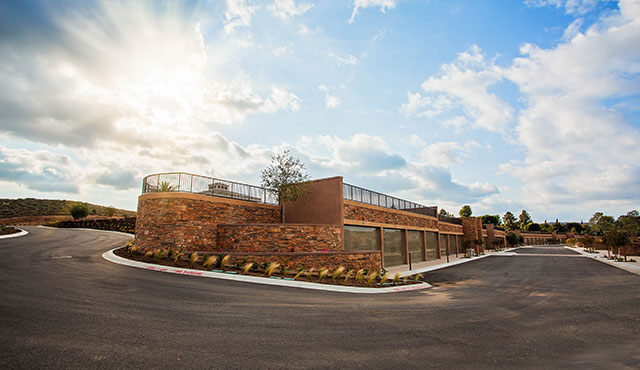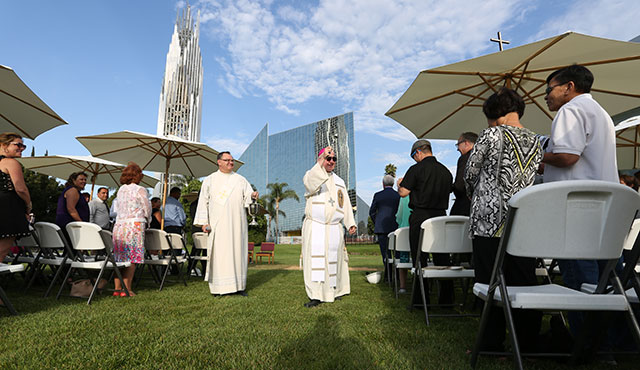On any given weekend, it is not uncommon to see hundreds of families visiting lost relatives across the Catholic cemeteries. Some come simply to place flowers or quietly reflect. To others is can be an entire family day or occasion.
“In California, especially in Catholic cemeteries, we get tremendous visitation,” said Michael Wesner, director of Catholic cemeteries.
It is a tradition Wesner helps keep alive through the management and caretaking of the six cemeteries encompassing more than 100 acres in Orange County.
Choosing the right burial spot is an important decision, not just for the deceased but the family. In Orange County, Catholic parishioners have choices not only in location, but how they are interred. Burials places can range from simple niches for cremated remains for about $3,000 plus burial fees to family estates with monuments and benches that can run into $100,000 to $200,000 and up.
But to Wesner, the importance has to do with more than just costs.
“Catholic cemeteries are reflections of our beliefs and values,” he said. “This is an integral part of our faith and our beliefs. We believe in the communion of saints and all our imagery is Catholic.”
The largest cemetery is 47-acre Holy Sepulchre in Orange, where about 45 percent of burials are held. Established in 1930 and upgraded recently with completion of the Mt. of Olives Mausoleum, the cemetery is where many of the diocesan priests are buried. It is the site for annual All Souls Day and Memorial Day Masses.
The 35-acre Good Shepherd’s Cemetery, formerly Roselawn, was purchased by the Los Angeles Diocese in 1952 and transferred to the Orange County Diocese in 1967. About 30 percent of local Catholic burials are held there.
Ascension Cemetery in Lake Forest is about 20 acres large and stages about 10 percent of burials, mostly in South County.
Memorial Gardens on the Christ Cathedral campus in Garden Grove is the newest cemetery.
The remaining two cemeteries are in San Juan Capistrano and Anaheim.
The cemetery on the grounds of the San Juan Capistrano mission, dating back to 1781, has been closed to burials since 1850. The limited burials still held, mostly for those with documented historical ties to the cemetery or mission, are east of the mission. It is believed there are more than 2,000, mostly Juaneno Indians, interred on the grounds in unmarked graves.
Msr. St. John O’Sullivan, who died in 1933 and is honored for his work to preserve and rebuild the mission, is buried in a crypt at the foot of a Celtic cross. The pastor originally erected the cross as a memorial to 40 native worshippers and two bell ringers, who died when the parish’s Great Stone Church collapsed in the 1812 San Juan Capistrano earthquake.
Holy Cross Cemetery in Anaheim, has been inactive for at least 15 years, but is still maintained by the church.
Each year about 7,000 to 10,000 Orange County Catholics are buried with about 30 percent of those choosing to go into a Catholic cemetery.
How Catholics are interred has changed. Although the Pope lifted the Church’s ban on cremations in 1963 and later allowed priests to officiate at funerals with cremated remains in 1966, the pace has accelerated in recent years.
Wesner said in his 15 years in Orange County the percentage has gone up every year with about 40 percent of Catholics choosing cremation over full-body burial.
In 2016, the Vatican reaffirmed cremation as an option, but added stricter guidelines on how remains are treated.
“In the view of the church, (ashes) should be treated the same as a full body,” Wesner said, noting that the Church prohibits the scattering of ashes, division of remains or keeping them in a home or a locket. Instead all of a person’s remains must remain together and buried in a sacred place.
Because of the reduced space required for ashes, projections for the lifespan of the Orange County cemeteries is expanding.
“The trend in cremations is changing the landscape,” Wesner said.
That is both literally and figuratively true. The design of the cemeteries is changing to accommodate more walls and niches, which can be offered with either traditional marble or glass fronts to display personalized urns.
Although Wesner said he and his wife already have a traditional crypt, the cemeteries’ director said, “I’m open to cremation. I would consider it for myself.”
The increase of cremations may also lead the church to revamp its 15-year-old cemeteries master plan, according to Wesner.
Wesner estimated the average cost for a burial is about $8,000. Free or reduced cost ceremonies for the needy, which Wesner said is part of the ministry, are available with a letter from a parish priest.
The cemeteries all have staffs to assist families.
“Our counselors are trained to advise Catholics on Catholic traditions and funeral rites,” Wesner said.
More information on Orange County’s Catholic cemeteries is available at occem.org.


